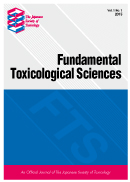Volume 10, Issue 7
Displaying 1-5 of 5 articles from this issue
- |<
- <
- 1
- >
- >|
Original Article
-
2023Volume 10Issue 7 Pages 279-285
Published: 2023
Released on J-STAGE: December 15, 2023
Download PDF (7532K)
Original Article
-
2023Volume 10Issue 7 Pages 287-293
Published: 2023
Released on J-STAGE: December 20, 2023
Download PDF (906K)
Letter
-
2023Volume 10Issue 7 Pages 295-300
Published: 2023
Released on J-STAGE: December 27, 2023
Download PDF (780K)
Letter
-
2023Volume 10Issue 7 Pages 301-306
Published: 2023
Released on J-STAGE: December 27, 2023
Download PDF (798K)
Letter
-
2023Volume 10Issue 7 Pages 307-313
Published: 2023
Released on J-STAGE: December 27, 2023
Download PDF (797K)
- |<
- <
- 1
- >
- >|
